|
The Day of the Dead
2007.10.31. 14:23
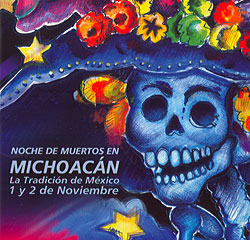 (El Día de los Muertos in Spanish) is a Mexican and Mexican-American celebration of deceased ancestors which occurs on November 1 and November 2, coinciding with the similar Roman Catholic celebrations of All Saints' Day and All Souls' Day. (El Día de los Muertos in Spanish) is a Mexican and Mexican-American celebration of deceased ancestors which occurs on November 1 and November 2, coinciding with the similar Roman Catholic celebrations of All Saints' Day and All Souls' Day.

History The origins of the celebration of The Day of the Dead in Mexico can be traced back to the indigenous peoples of Latin America, such as the Aztecs, Mayans Purepecha, Nahua and Totonac. Rituals celebrating the lives of dead ancestors had been performed by these Mesoamerican civilizations for at least 3,000 years. It was common practice to keep skulls as trophies and display them during rituals to symbolize death and rebirth.  The festival which was to become El Día de los Muertos fell on the ninth month of the Aztec Solar Calendar, near the start of August, and was celebrated for the entire month. Festivities were presided over by the goddess Mictecacihuatl, known as the "Lady of the Dead". The festivities were dedicated to the celebration of children and the lives of dead relatives. When the Spanish Conquistadors arrived in Central America in the 15th century they were appalled at the indigenous pagan practices, and in an attempt to convert the locals to Catholicism moved the popular festival to the beginning of November to coincide with the Catholic All Saints and All Souls days. All Saints' Day is the day after Halloween, which was in turn based on the earlier pagan ritual of Samhain, the Celtic day and feast of the dead. The Spanish combined their custom of Halloween with the similar Mesoamerican festival, creating The Day of the Dead. Contrary to what one might think, this 3,000-year-old Aztec holiday is actually a joyous celebration, and features visits to graveyards to leave flowers and lighted candles in honor of the dead. The souls of children are believed to visit earth on November 1, with adults's souls following the next day.
History of HalloweenIt is probably that the modern Halloween (a word we first meet in the 17th Century) originated from an ancient Celtic harvest holiday called Samhain, meaning Summer's End. This festival is also known as Hallowanas, All Hallow’s Eve, All Saint’s Eve, Festival of the Dead, and the Third Festival of Harvest. This holiday of Samhain is closely associated with witches, and is celebrated by modern wiccans today. Samhain was the Celtic New Year, in which the celebrating could not begin until sundown. Samhain was also known as the ’’ The Feast of the Living Dead’’, because it was believed that the dead would come back to life, eat and celebrate with the living. These two facts explain the reasoning for why Halloween is celebrated at night and why costumes of dead and other horrifying things are worn. 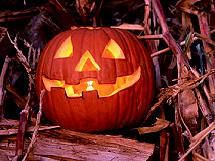 But Halloween is also connected to the celebration of the Catholic feast of All Saints' Day. This holiday celebrated on the first of November is the honouring of all the saints, known and unknown. All Saints Day grew from very small roots. In the beginning, every saint was given a special dayon which to be honoured. However, this soon became problematic as the number of saints grew to be too many. In the late fourth century, the church selected a day to honour only martyrs and St. John the Baptist. As time went on, others were gradually added and the celebration took place the Friday a week before Easter. In 609, Pope Boniface IV ordered an anniversary to celebrate the martyrs and Blessed Virgin after he consecrated the Pantheon in Rome to them. This ignited an idea for Gregory III and in 800, a chapel in St. Peter’s was consecrated to All Saints and the anniversary was set for 1 November. There was still a problem with this, only certain people in the church could celebrate the holiday until in 837, Gregory IV opened the celebration to the entire church, maintaining the date of 1 November. But Halloween is also connected to the celebration of the Catholic feast of All Saints' Day. This holiday celebrated on the first of November is the honouring of all the saints, known and unknown. All Saints Day grew from very small roots. In the beginning, every saint was given a special dayon which to be honoured. However, this soon became problematic as the number of saints grew to be too many. In the late fourth century, the church selected a day to honour only martyrs and St. John the Baptist. As time went on, others were gradually added and the celebration took place the Friday a week before Easter. In 609, Pope Boniface IV ordered an anniversary to celebrate the martyrs and Blessed Virgin after he consecrated the Pantheon in Rome to them. This ignited an idea for Gregory III and in 800, a chapel in St. Peter’s was consecrated to All Saints and the anniversary was set for 1 November. There was still a problem with this, only certain people in the church could celebrate the holiday until in 837, Gregory IV opened the celebration to the entire church, maintaining the date of 1 November.
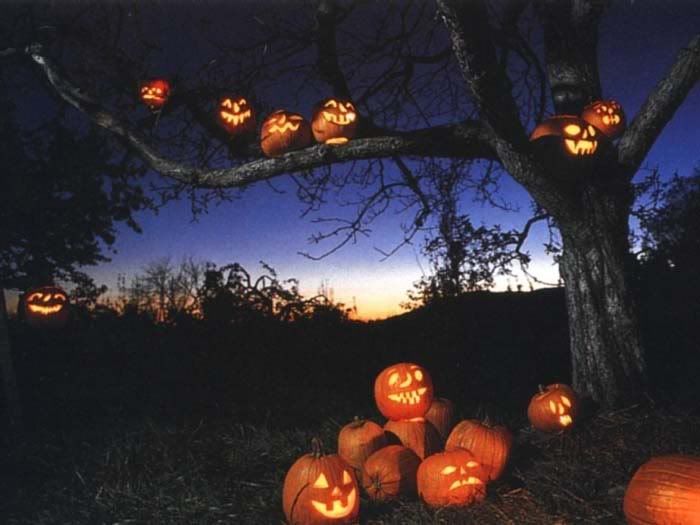
All the common traditions of today Halloween can be attributed to the ancient Celtic tradition of Samhain. Trick or treating was done by everyone, and ironically it focused more on the adults than the children. Instead of the children going from door to door, the adults would go from house to house receiving treats, which was usually liquor, and they would go caroling along in bands, The fun game of bobbing for apples was a marriage tradition, in which who ever got the apple would be married later that year. In Scotland and Ireland, the idea of the Jack-O-lantern was used to protect the house from evil spirits which could harm the family. In modern Britain, where the festival is much less of an event than in the US, Lanterns are made with swedes (what Americans call rutabagas) rather than pumpkins David Earle, Stephanie Fike, and Michael Galkoski 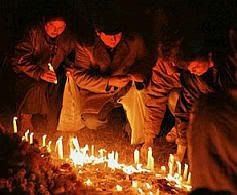 Different traditions around the world Different traditions around the world
However, it seems the rest of the world is less keen to be so extravagant and many countries keep it part religious and part fun. Across much of Europe, including Germany, Austria, Italy and Spain, the period from 30th October through to the 8th November is known as All Souls Week and Catholics attend church services in honour of the saints, the martyrs and those who have died for the Catholic faith. The customs throughout much of the world reflect the original beliefs that the dead came back to earth on Hallowe'en. People in Germany put away their knives so they cannot hurt returning spirits, those in Japan place food and water in front of photos of their loved ones and light candles to guide their journey back to earth. In the Philipines, candles are lit in memory of dead relatives and in Mexico, people picnic on their relatives' graves as it is a day of remembrance, happiness and celebration. And it seems the Canadians have the best ideas. They place Jack-O' Lanterns in their windows to welcome trick-or-treaters. No lantern means stay away! 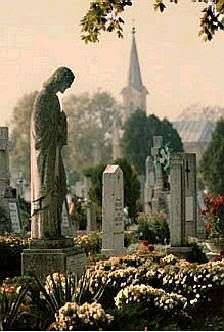 In Hungary called "Mindenszentek" and the Day of Dead "Halottak napja" is connected to one fest, the people are going to the cemetery to remember the ancestors, to peace up and to decorate, beautify the graves with flowers (mostly chrysanthemum and aster - flowers of passing). Whereon its going darken the cemeterys are floating in countless candle and lampion lights, you can feel the emotion and adoration in there. According to the folklore its believed that the spirits of the dead were allowed to come back to earth to celebrate with the living on this day. People were afraid of what the spirits may do to them, so they started to dress up to disguise themselves. They would roam the streets in these disguises trying to fool the spirits into believing that they weren't living beings. Of course the costumes weren't nearly as elaborate as they are today, and were usually scary costumes. People would wear rags and smear ashes on their faces to disguise themselves and keep the spirits of the dead away.
Here are the most notable Irish Halloween Traditions: Colcannon for Dinner: Boiled Potato, Curly Kale (a cabbage) and raw Onions are provided as the traditional Irish Halloween dinner. Clean coins are wrapped in baking paper and placed in the potato for children to find and keep. The Barnbrack Cake: The traditional Halloween cake in Ireland is the barnbrack which is a fruit bread. Each member of the family gets a slice. Great interest is taken in the outcome as there is a piece of rag, a coin and a ring in each cake. If you get the rag then your financial future is doubtful. If you get the coin then you can look forward to a prosperous year. Getting the ring is a sure sign of impending romance or continued happiness. The Ivy Leaf: Each member of the family places a perfect ivy leaf into a cup of water and it is then left undisturbed overnight. If, in the morning, a leaf is still perfect and has not developed any spots then the person who placed the leaf in the cup can be sure of 12 months health until the following Halloween. If not..... The Pumpkin: Carving Pumpkins dates back to the eighteenth century and to an Irish blacksmith named Jack who colluded with the Devil and was denied entry to Heaven. He was condemned to wander the earth but asked the Devil for some light. He was given a burning coal ember which he placed inside a turnip that he had gouged out. 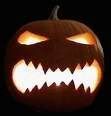 The tradition of Jack O'Lanterns was born - the bearer being the wandering blacksmith - a damned soul. Villagers in Ireland hoped that the lantern in their window would keep the wanderer away. When the Irish emigrated in millions to America there was not a great supply of turnips so pumpkins were used instead. The tradition of Jack O'Lanterns was born - the bearer being the wandering blacksmith - a damned soul. Villagers in Ireland hoped that the lantern in their window would keep the wanderer away. When the Irish emigrated in millions to America there was not a great supply of turnips so pumpkins were used instead.
Halloween Costumes: On Halloween night children would dress up in scary costumes and go house to house. 'Help the Halloween Party' and 'Trick or Treat' were the cries to be heard at each door. This tradition of wearing costumes also dates back to Celtic times. On the special night when the living and the dead were at their closest the Celtic Druids would dress up in elaborate costumes to disguise themselves as spirits and devils in case they encountered other devils and spirits during the night. By disguising they hoped that they would be able to avoid being carried away at the end of the night. This explains why witches, goblins and ghosts remain the most popular choices for the costumes. Snap Apple: After the visits to the neighbours the Halloween games begin, the most popular of which is Snap Apple. An apple is suspended from a string and children are blindfolded. The first child to get a decent bite of the apple gets to keep their prize. The same game can be played by placing apples in a basin of water and trying to get a grip on the apple without too much mess! The Bonfire: The Halloween bonfire is a tradition to encourage dreams of who your future husband or wife is going to be. The idea was to drop a cutting of your hair into the burning embers and then dream of you future loved one. Halloween was one of the Celt 'fire' celebrations. Blind Date: Blindfolded local girls would go out into the fields and pull up the first cabbage they could find. If their cabbage had a substantial amount of earth attached to the roots then there future loved one would have money. Eating the cabbage would reveal the nature of their future husband - bitter or sweet! Blindfolded local girls would go out into the fields and pull up the first cabbage they could find. If their cabbage had a substantial amount of earth attached to the roots then there future loved one would have money. Eating the cabbage would reveal the nature of their future husband - bitter or sweet! Another way of finding your future spouse is to peel an apple in one go. If done successfully the single apple peel could be dropped on the floor to reveal the initials of the future-intended. Anti-Fairy Measures: Fairies and goblins try to collect as many souls as they can at Halloween but if they met a person who threw the dust from under their feet at the Fairy then they would be obliged to release any souls that they held captive.
Holy water was sometimes anointed on farm animals to keep them safe during the night. If the animals were showing signs of ill health on All Hallows Eve then they would be spat on to try to ward off any evil spirits.
The tradition of Halloween came to the United States in 1840,
with the arrival of a group of Irish immigrants. From there it
slowly evolved into our modern day version of Halloween, with
kids dressing up as Dora the Explorer (tm) and Power Rangers
(tm), pretending to be their favorite TV characters.
While the spirit of Halloween and the meaning behind it have
changed over the centuries, it is still a holiday that allows
us to pretend to be someone else, by dressing down in rags and
blackening our face to hide it, or by wearing a fancy costume
with a mask, or using face paint to disguise our appearance.
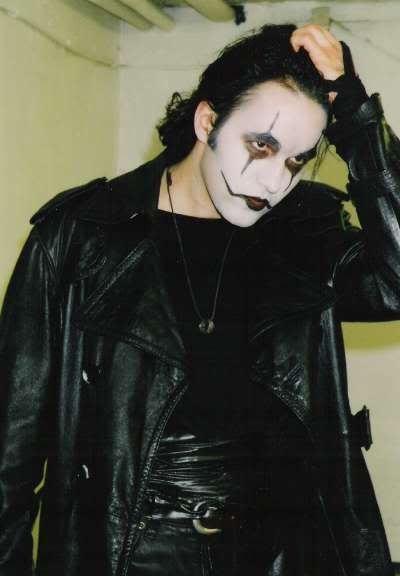 Me, couple of years ago on Halloween dressed/ The Crow
| 
